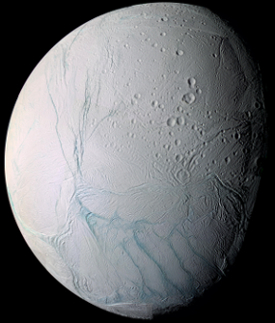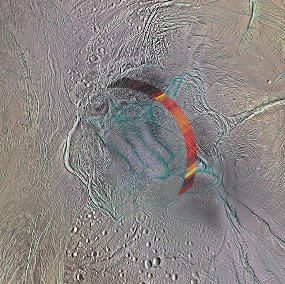Enceladus' south pole is warm under the frost
13 March 2017
Over the past decade, the international Cassini mission has revealed intense activity at the southern pole of Saturn's icy moon, Enceladus, with warm fractures venting water-rich jets that hint at an underground sea. A new study, based on microwave observations of this region, shows that the moon is warmer than expected just a few metres below its icy surface. This suggests that heat is produced over a broad area in this polar region and transported under the crust, and that Enceladus' reservoir of liquid water might be lurking only a few kilometres beneath. |
| False-colour image of Enceladus highlighting the tiger stripes in blue. Credit: NASA/JPL/Space Science Institute |
In 2005, observations by the NASA/ESA/ASI Cassini mission revealed plumes of water vapour and ice spraying into space from the south pole of Enceladus, the sixth-largest moon of Saturn. These jets originate from the so-called 'tiger stripes' – four warm fractures in the moon's icy surface. The salty composition of these jets points to an underground sea of liquid water that might interact with Enceladus' rocky core, similar to the sub-surface ocean that is thought to exist on Jupiter's moon, Europa.
Many of Cassini's flybys of Enceladus have been dedicated to understanding the structure of the interior of this fascinating body and its potentially habitable water reservoir. Now, a study based on data collected during a close flyby in 2011 indicates that the moon's hidden sea might be closer to the surface than previously thought.
"During this flyby, we obtained the first and, unfortunately, only high-resolution observations of Enceladus' south pole at microwave wavelengths," says Alice Le Gall from Laboratoire Atmosphères, Milieux, Observations Spatiales (LATMOS), and Université Versailles Saint-Quentin (UVSQ), France. Alice is an associate member of the Cassini RADAR instrument team and the lead scientist of the new study, published today in Nature Astronomy.
"These observations provide a unique insight into what is going on beneath the surface. They show that the first few metres below the surface of the area that we investigated, although at a glacial 50-60 K, are much warmer than we had expected: likely up to 20 K warmer in some places," she adds.
"This cannot be explained only as a result of the Sun's illumination and, to a lesser extent, Saturn’s heating so there must be an additional source of heat."
The detected heat appears to be lying under a much colder layer of frost, as no similar anomaly was found in infrared observations of the same region – these probe the temperature of the surface but are not sensitive to what is underneath.
The observations used by Alice and her collaborators cover a narrow, arc-shaped swathe of the southern polar region, about 500 km long and 25 km wide, and located just 30 km to 50 km north of the tiger-stripe fractures. Because of operational constraints of the 2011 flyby, it was not possible to obtain microwave observations of the active fractures themselves. This had the benefit of allowing the scientists to observe that the thermally anomalous terrains of Enceladus extend well beyond the tiger stripes.
 |
| Tiger stripes on the south pole of Enceladus. The region studied is indicated by the coloured band. Credit: NASA/JPL-Caltech/Space Science Institute |
"The thermal anomaly we see at microwave wavelengths is especially pronounced over three fractures that are not unlike the tiger stripes, except that they don't seem to be the source of jets at the moment," Alice says.
These seemingly dormant fractures lying above the warm, underground sea point to a dynamic character of Enceladus' geology: the moon may have experienced several episodes of activity at different locations during its past history.
Even if the observations cover only a small patch of the southern polar terrains, it is likely that the entire region is warm underneath and Enceladus' ocean could be a mere 2 km under the icy surface. The finding agrees well with the results of a recent study, led by Ondrej Cadek and published in 2016, which estimated the thickness of the crust on Enceladus. With an average depth of 18–22 km, the ice shell appears to reduce to less than 5 km at the south pole.
Alice and her collaborators think that the underground heating source is linked to the tidal cycle of the moon along its eccentric orbit around Saturn. This induces stress compressions and deformations on the crust, leading to the formation of faults and fractures while at the same time heating up the sub-surface layers. In this scenario, the thinner icy crust in the south pole region is subject to a larger tidal deformation that, in turn, releases more heat and contributes to maintaining the underground water in liquid form.
"This discovery opens new perspectives to investigate the emergence of habitable conditions on the icy moons of the gas giant planets," says Nicolas Altobelli, ESA's Project Scientist for Cassini–Huygens.
"If Enceladus' underground sea is really as close to the surface as this study indicates, then a future mission to this moon carrying an ice-penetrating radar sounding instrument might be able to detect it."
Notes for Editors
"Thermally anomalous features in the subsurface of Enceladus’s south polar terrain" by A. Le Gall et al. (2017) is published in Nature Astronomy; doi: 10.1038/s41550-017-0063
Cassini–Huygens is a cooperative project of NASA, ESA and ASI, the Italian space agency.
For further information, please contact:
Alice Le Gall
Laboratoire Atmosphères, Milieux, Observations Spatiales (LATMOS)
Université Versailles Saint-Quentin (UVSQ)
Paris, France
Email: Alice.Legall![]() latmos.ipsl.fr
latmos.ipsl.fr
Nicolas Altobelli
ESA Cassini–Huygens Project Scientist
Directorate of Science
European Space Agency
Phone: +34 91 813 1201
Email: nicolas.altobelli![]() esa.int
esa.int



